Styles in Evening Gowns - February 1904
Madame de Pompadour seems the direct inspiration of the evening dress of the present day, and the skirts, plain in front with much fullness at the sides and back, especially suggest eighteenth-century modes. True, we are spared the crinoline bugbear which is constantly threatening but will probably never arrive.
Skirts and Underskirts
Skirts will be voluminous; there will be many yards of material in them if one desires to go to extremes, but at the same time a clinging effect will be adhered to. The skirt must be billowy about the feet, with ripples and cascades of fullness if one wishes, but all soft and graceful, without the slightest stiffness.
While some gown makers advocate the introduction of a wire in the flounces of the underskirt, it is not advisable, and if used must be handled very skillfully. Stiff cord or the lightest of skirt featherbone, placed near the edge of the plaiting on the drop skirt and hidden by the ruching, answers the purpose more satisfactorily.
Sleeves
Large sleeves, deep berthas and shoulder capes and high girdles are the distinctive features of waists, and these, together with the full shirred and plaited skirts, come under the designation “1830,” being modifications of the styles of that time.
Sleeves are in considerable variety, mostly elbow length but always close and small at the shoulder, spreading to their greatest fulness at the elbow and finishing there as a puff or having a deep Watteau frill.
Lace
Lace is extensively used, some of the berthas being entirely of lace while others are of the gown material with lace applied or inset. The narrow plaitings and quillings which have not been seen for a number of years are revived, with good effect, trimming both skirts and blouses.
Tiny button roses made of chiffon and interspersed with green leaves are mounted on bands and used to edge the décolletage of blouses and to head ruffles. This banding may be bought by the yard or is entirely within the skill of the average dressmaker.
Roses, sweet peas, fuchsias, and cherries are made of chiffon with long stems of chenille and hung as a fringe from these bands, giving an effect that is very light and pretty.
Evening Gown Color Selection
Pale colors are naturally chosen for evening gowns, the delicate shades of yellow, gray, green, blue, pink, and, of course, white. Chiffon cloth crepe de Chine and the many silky weaves of voile, all lend themselves admirably to the full shirred and plaited modes, while Liberty satin is asserting itself as a favorite for gowns of less fluffy effect, a rich simplicity being the key-note.
Quality in Dressmaking
Handwork is seen in tuckings, shirrings, and fancy stitches. Seams are joined with fagoting, and this and Mexican stitch are introduced as an insertion in skirts and waists in both vertical and horizontal lines.
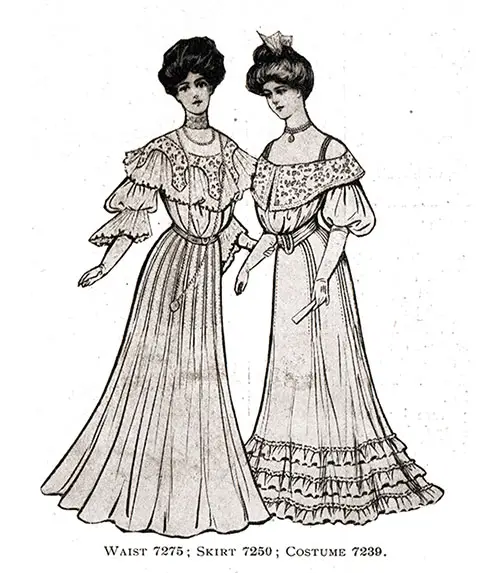
7275—7250. — The skirt of this attractive Gown is laid in small box-plaits which may be stitched flat a distance down from the waist, to simulate a yoke. It would look well made of veiling or crepe de Chine, the box-plaits being held in place by French knots instead of stitching.
The bottom of the skirt may be ornamented with French knots worked on in wavy lines and of different sizes, using several strands of embroidery silk threaded into a large-eyed crewel needle for the lowest row and gradually lessening the number of strands toward the top row, or lace insertion may be introduced.
The blouse is made to correspond with this skirt by ornamenting the bertha, the sleeve frills and the box-plaits with French knots. The pattern also provides a yoke and long sleeves and may be varied in trimming to match the skirt.
The price of the skirt pattern, 7250, is 25 cents, and that of the waist, 7275, is 20 cents.
7239 (See above illustration). — At this figure is shown a costume composed of a circular skirt which is held close over the hips by tucks in clusters, the bottom of the skirt being finished with quaint little frills in either straight or festoon-shaped rows.
The bertha may be of all-over lace or the same material as the gown, edged with the tiny frills and the shoulder-straps trimmed with bands of little chiffon roses with a cluster of them hanging from the point where they join the waist in front.
The pattern costs 25 cents.
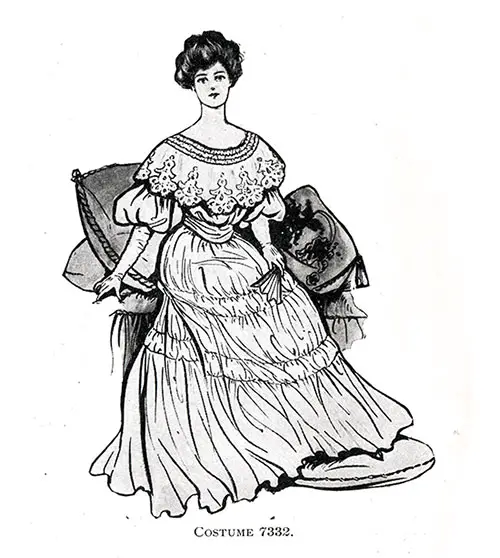
7332.—This costume has a circular skirt which is held close to the figure at the hips and again at the knees by two rows of shirring, while upon the waist several rows of close shirring encircle the neck above a bertha which is ornamented with flat applications of lace motifs.
The price of the pattern is 25 cents.
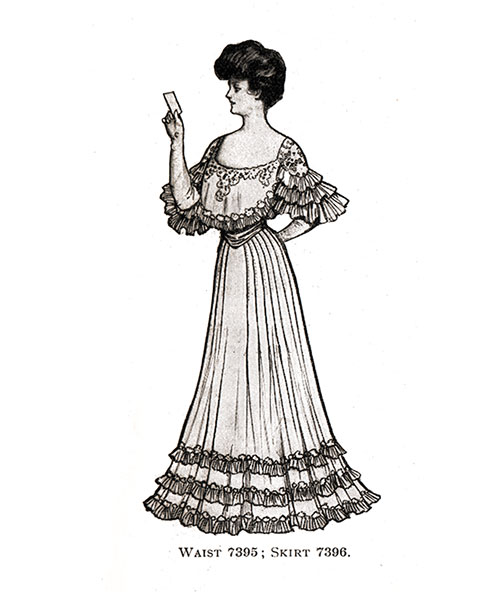
7395—7396. — This Evening Gown Costume also includes a circular skirt which may be shirred at the waistline or laid in plaits, leaving a plain panel in the front. The bottom of the skirt is trimmed with little frills headed with a tiny puffing or with garlands of button roses.
The blouse has a bolero-like drapery and a very novel arrangement of the sleeves, the close-fitted cap being of lace and the rest of the sleeve composed of the little frills in graduated widths. A high girdle gives a characteristic touch to this quaint and artistic gown.
The price of the waist pattern is 20 cents and that of the skirt 25 cents.
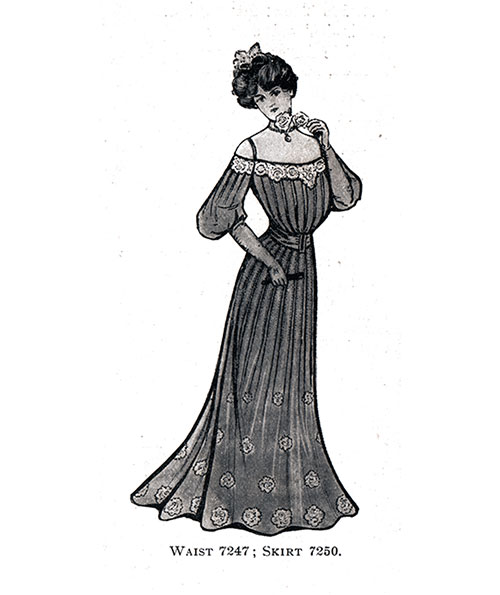
7247—7250. — At this illustration is shown an attractive combination of two box-plaited models. A very charming gown of elegant simplicity could be made from soft Liberty satin, a band of Irish lace encircling the top of the waist and sleeves and motifs of the same lace inset at intervals in the skirt.
The pattern of the waist costs 20 cents and that of the skirt 25 cents.
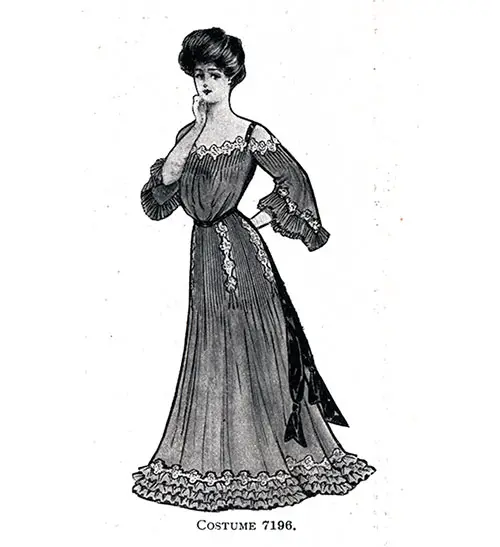
7196—A simple and girlish costume is here portrayed. The skirt is cut in five gores, which gives a graceful flowing line from waist to hem while preserving the appearance of a straight full skirt.
The fullness is held in place over the hips by tiny tucks which may be finished in Vandyke outline as may also the tucks-in the waist and sleeves. The latter is of the kimono shape, though the pattern provides both yoke and long full sleeves drawn into cuffs.
The price of the pattern is 25 cents.
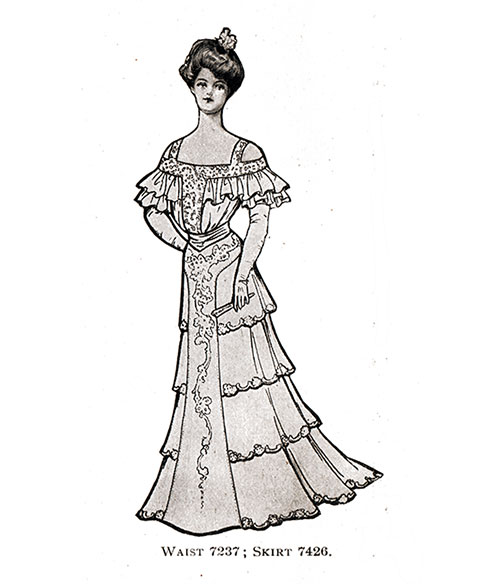
7237—7426. — This is another evening gown which will develop well in Liberty satin, rich lace edging the four flounces which compose the skirt and incrusting its yoke and front panel.
The band decoration of the waist and the plastron which extends from it as well as the shoulder straps should have the lace applied in the same manner as the skirt.
The bertha and sleeves may be of Liberty chiffon with a hem attached by faggoting or Mexican stitch. The pattern of the waist costs 20 cents and the skirt 25 cents.
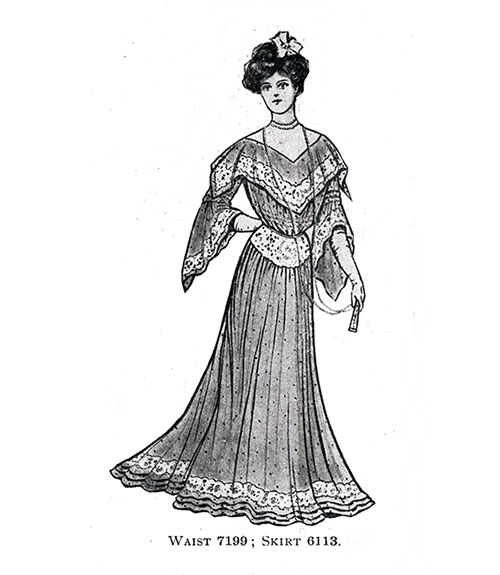
7199—6113. — The material of this gown was a dotted silk muslin, pale gray in shade, with trimming and yoke of point de Venise.
The full skirt is shirred into the yoke and shirring occurs again in the blouse and sleeves. The distinctive feature is the handkerchief bertha, giving the popular long-shouldered effect.
The price of the waist pattern is 20 cents and the skirt 25 cents.
In gowns of low shouldered effect, if a piece of half-inch elastic is placed between the shoulder strap and its facing, the elastic being from one to two inches shorter than the strap, the difficulty of keeping the shoulder in place will be overcome without interfering with freedom of movement.
Terminology
Plaiting: anything that is braided or pleated. (dictionary.com)
Quilling or paper filigree is an art form that involves the use of strips of paper that are rolled, shaped, and glued together to create decorative designs. (Wikipedia)
Shirrings: gather (an area of fabric or part of a garment) utilizing drawn or elasticized threads in parallel rows. (Oxford University Press)
“Styles in Evening Gowns,” in The Delineator: An Illustrated Magazine of Literature and Fashion, Paris-London-New York-Toronto: The Butterick Publishing Co. Ltd., Vol. LXIII, No. 2, February 1904, p. 336-339.
Editor's Note: Some terminology used in the description of women's clothing during the 1800s and early 1900s has been changed to reflect more modern terms. For example, a women's "Toilette" -- a form of costume or outfit has an entirely different common meaning in the 21st century. Typical terms applied to "toilette" include outfit, ensemble, or costume, depending on context.
Note: We have edited this text to correct grammatical errors and improve word choice to clarify the article for today’s readers. Changes made are typically minor, and we often left passive text “as is.” Those who need to quote the article directly should verify any changes by reviewing the original material.
